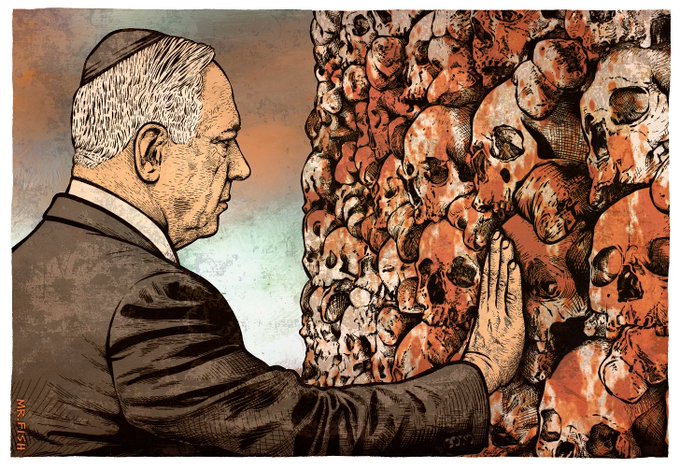There will be no peace in Gaza. Only the temporary absence of war.
Chris Hedges is a Pulitzer Prize–winning journalist who was a foreign correspondent for fifteen years for The New York Times, where he served as the Middle East Bureau Chief and Balkan Bureau Chief for the paper. He previously worked overseas for The Dallas Morning News, The Christian Science Monitor, and NPR. He is the host of show The Chris Hedges Report.
Cross-posted from Chris Hedges Substack
The Wailing Wall – by Mr. Fish
There is no shortage of failed peace plans in occupied Palestine, all of them incorporating detailed phases and timelines, going back to the presidency of Jimmy Carter. They end the same way. Israel gets what it wants initially — in the latest case the release of the remaining Israeli hostages — while it ignores and violates every other phase until it resumes its attacks on the Palestinian people.
It is a sadistic game. A merry-go-round of death. This ceasefire, like those of the past, is a commercial break. A moment when the condemned man is allowed to smoke a cigarette before being gunned down in a fusillade of bullets.
Once Israeli hostages are released, the genocide will continue. I do not know how soon. Let’s hope the mass slaughter is delayed for at least a few weeks. But a pause in the genocide is the best we can anticipate. Israel is on the cusp of emptying Gaza, which has been all but obliterated under two years of relentless bombing. It is not about to be stopped. This is the culmination of the Zionist dream. The United States, which has given Israel a staggering $22 billion in military aid since Oct, 7, 2023, will not shut down its pipeline, the only tool that might halt the genocide.
Israel, as it always does, will blame Hamas and the Palestinians for failing to abide by the agreement, most probably a refusal — true or not — to disarm, as the proposal demands. Washington, condemning Hamas’s supposed violation, will give Israel the green light to continue its genocide to create Trump’s fantasy of a Gaza Riviera and “special economic zone” with its “voluntary”relocation of Palestinians in exchange for digital tokens.
Of the myriads of peace plans over the decades, the current one is the least serious. Aside from a demand that Hamas release the hostages within 72-hours after the ceasefire begins, it lacks specifics and imposed timetables. It is filled with caveats that allow Israel to abrogate the agreement. And that is the point. It is not designed to be a viable path to peace, which most Israeli leaders understand. Israel’s largest-circulation newspaper, Israel Hayom, established by the late casino magnate Sheldon Adelson to serve as a mouthpiece for Prime Minister Benjamin Netanyahu and champion messianic Zionism, instructed its readers not to be concerned about the Trump plan because it is only “rhetoric.”
Israel, in one example from the proposal, will “not return to areas that have been withdrawn from, as long as Hamas fully implements the agreement.”
Who decides if Hamas has “fully implemented” the agreement? Israel. Does anyone believe in Israel’s good faith? Can Israel be trusted as an objective arbitrator of the agreement? If Hamas — demonized as a terrorist group — objects, will anyone listen?
How is it possible that a peace proposal ignores the International Court of Justice’s July 2024 Advisory Opinion, which reiterated that Israel’s occupation is illegal and must end?
How can it fail to mention the Palestinian’s right to self-determination?
Why are Palestinians, who have a right under international law to armed struggle against an occupying power, expected to disarm while Israel, the illegally occupying force, is not?
By what authority can the U.S. establish a “temporary transitional government,” — Trump’s and Tony Blair’s so-called “Board of Peace” — sidelining the Palestinian right to self-determination?
Who gave the U.S. the authority to send to Gaza an “International Stabilization Force,” a polite term for foreign occupation?
How are Palestinians supposed to reconcile themselves to the acceptance of an Israeli “security barrier” on Gaza’s borders, confirmation that the occupation will continue?
How can any proposal ignore the slow-motion genocide and annexation of the West Bank?
Why is Israel, which has destroyed Gaza, not required to pay reparations?
What are Palestinians supposed to make of the demand in the proposal for a “deradicalized” Gazan population? How is this expected to be accomplished? Re-education camps? Wholesale censorship? The rewriting of the school curriculum? Arresting offending Imams in mosques?
And what about addressing the incendiary rhetoric routinely employed by Israeli leaders who describe Palestinians as “human animals” and their children as “little snakes”?
“All of Gaza and every child in Gaza, should starve to death,” the Israeli rabbi Ronen Shaulov announced. “I don’t have mercy for those who, in a few years, will grow up and won’t have mercy for us. Only a stupid fifth column, a hater of Israel has mercy for future terrorists, even though today they are still young and hungry. I hope, may they starve to death, and if anyone has a problem with what I’ve said, that’s their problem.”
Israeli violations of peace agreements have historical precedents.
The Camp David Accords, signed in 1978 by Egyptian president Anwar Sadat and Israeli prime minister Menachem Begin — without the participation of the Palestine Liberation Organization (PLO) — led to the 1979 Egypt-Israel Peace Treaty, which normalized diplomatic relations between Israel and Egypt.
Subsequent phases of the Camp David Accords, which included a promise by Israel to resolve the Palestinian question along with Jordan and Egypt, permit Palestinian self-governance in the West Bank and Gaza within five years, and end the building of Israeli colonies in the West Bank, including East Jerusalem, were never implemented.
The 1993 Oslo Accords, signed in 1993, saw the PLO recognize Israel’s right to exist and Israel recognize the PLO as the legitimate representatives of the Palestinian people. Yet, what ensued was the disempowerment of the PLO and its transformation into a colonial police force. Oslo II, signed in 1995, detailed the process towards peace and a Palestinian state. But it too was stillborn. It stipulated that any discussion of illegal Jewish “settlements” were to be delayed until “final” status talks. By then, Israeli military withdrawals from the occupied West Bank were scheduled to have been completed. Governing authority was poised to be transferred from Israel to the supposedly temporary Palestinian Authority. Instead, the West Bank was carved up into Areas A, B and C. The Palestinian Authority had limited authority in Areas A and B while Israel controlled all of Area C, over 60 percent of the West Bank.
The right of Palestinian refugees to return to the historic lands that Jewish settlers seized from them in 1948 when Israel was created — a right enshrined in international law — was given up by the PLO leader Yasser Arafat. This instantly alienated many Palestinians, especially those in Gaza where 75 percent are refugees or the descendants of refugees. As a consequence, many Palestinians abandoned the PLO in favor of Hamas. Edward Said called the Oslo Accords “an instrument of Palestinian surrender, a Palestinian Versailles” and lambasted Arafat as “the Pétain of the Palestinians.”
The scheduled Israeli military withdrawals under Oslo never took place. There were around 250,000 Jewish colonists in the West Bank when the Oslo agreement was signed. Their numbers today have increased to at least 700,000.
The journalist Robert Fisk called Oslo “a sham, a lie, a trick to entangle Arafat and the PLO into abandonment of all that they had sought and struggled for over a quarter of a century, a method of creating false hope in order to emasculate the aspiration of statehood.”
Israel unilaterally broke the last two-month-long ceasefire on March 18 of this year when it launched surprise airstrikes on Gaza. Netanyahu’s office claimed that the resumption of the military campaign was in response to Hamas’s refusal to release hostages, its rejection of proposals to extend the cease-fire and its efforts to rearm. Israel killed more than 400 people in the initial overnight assault and injured over 500, slaughtering and wounding people as they slept. The attack scuttled the second stage of the agreement, which would have seen Hamas release the remaining living male hostages, both civilians and soldiers, for an exchange of Palestinian prisoners and the establishment of a permanent ceasefire along with the eventual lifting of the Israeli blockade of Gaza.
Israel has carried out murderous assaults on Gaza for decades, cynically calling the bombardment “mowing the lawn.” No peace accord or ceasefire agreement has ever gotten in the way. This one will be no exception.
This bloody saga is not over. Israel’s goals remain unchanged: the dispossession and erasure of Palestinians from their land.
The only peace Israel intends to offer the Palestinians is the peace of the grave.



Be the first to comment